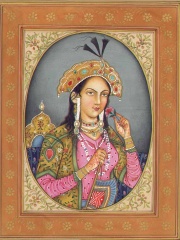
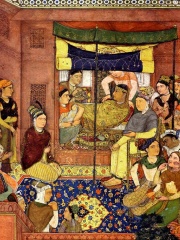
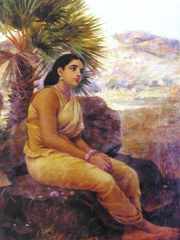
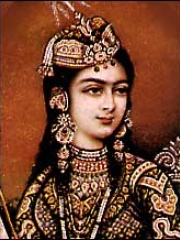
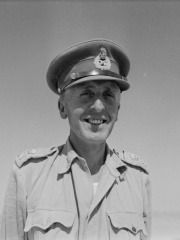
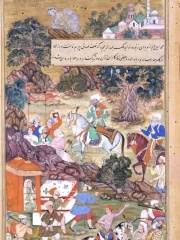

The Most Famous
COMPANIONS from India
This page contains a list of the greatest Indian Companions. The pantheon dataset contains 784 Companions, 8 of which were born in India. This makes India the birth place of the 18th most number of Companions behind Czechia, and Hungary.
Top 8
The following people are considered by Pantheon to be the most legendary Indian Companions of all time. This list of famous Indian Companions is sorted by HPI (Historical Popularity Index), a metric that aggregates information on a biography's online popularity.

1. Mumtaz Mahal (1593 - 1631)
With an HPI of 85.84, Mumtaz Mahal is the most famous Indian Companion. Her biography has been translated into 66 different languages on wikipedia.
Mumtaz Mahal (Persian pronunciation: [mum.ˈtɑːz ma.ˈhal]; lit. 'The Exalted One of the Palace'; born Arjumand Banu Begum; 27 April 1593 – 17 June 1631) was the empress consort of Mughal Empire from 1628 to 1631 as the chief consort of the fifth Mughal emperor, Shah Jahan. The Taj Mahal in Agra, often cited as one of the Wonders of the World, was commissioned by her husband to act as her tomb. Mumtaz Mahal was born Arjumand Banu Begum in Agra to a family of Persian nobility. She was the daughter of Abu'l-Hasan Asaf Khan, a wealthy Persian noble who held high office in the Mughal Empire, and the niece of Empress Nur Jahan, the chief consort of Emperor Jahangir and the power behind the emperor. Arjumand Banu was married at the age of 19 on 10 May 1612 or 16 June 1612 to Prince Khurram, later known by his regnal name Shah Jahan, who conferred upon her the title "Mumtaz Mahal" lit. 'The Exalted One of the Palace'. Although betrothed to Shah Jahan since 1607, she ultimately became his second wife in 1612. Mumtaz and her husband had 14 children, including Jahanara Begum (Shah Jahan's favorite daughter), and the Crown prince Dara Shikoh, the heir-apparent, anointed by his father, who temporarily succeeded him until deposed by Mumtaz Mahal's sixth child, Aurangzeb, who ultimately succeeded his father as the sixth Mughal emperor in 1658. Mumtaz Mahal died in 1631 in Burhanpur, Deccan (present-day Madhya Pradesh) during the birth of her 14th child, a daughter named Gauhar Ara Begum. Shah Jahan had the Taj Mahal built as a tomb for her, which is considered to be a monument of undying love. As with other Mughal royal ladies, no contemporary likenesses of her are accepted, but imagined portraits were created from the 19th century onwards.

2. Mariam-uz-Zamani (1542 - 1623)
With an HPI of 73.82, Mariam-uz-Zamani is the 2nd most famous Indian Companion. Her biography has been translated into 34 different languages.
Mariam-uz-Zamani (lit. 'Mary/Compassionate of the Age'; c. 1542 – 19 May 1623), commonly known by the misnomer Jodha Bai, was the chief consort, principal Hindu wife and the favourite wife of the third Mughal emperor, Akbar. She was also the longest-serving Hindu empress of the Mughal Empire with a tenure of forty-three years (1562–1605). Born as a Rajput princess, she was married to Akbar by her father, Raja Bharmal of Amer due to political exigencies. Her marriage to Akbar led to a gradual shift in the latter's religious and social policies. She is widely regarded in modern Indian historiography as exemplifying both Akbar's tolerance of religious differences and their inclusive policies within an expanding multi-ethnic and multi-religious empire. She was said to possess uncommon beauty and was widely known for both her grace and intellect. She occupied an important place in Akbar's harem and was senior-ranking wife of Akbar who in the words of Abu'l-Fazl ibn Mubarak, commanded a high rank in the imperial harem. Mariam-uz-Zamani is described as an intellectual, amiable, kind and auspicious woman who held many privileges during her time as empress consort and queen mother of the Mughal Empire. She was the favourite and an influential consort of Akbar who had substantial personal wealth and was regarded as one of the wealthiest women of her time. She is regarded as the most prodigious woman trader of the Mughal empire who helped chart the role of Mughal women in the newly expanding business of foreign trade. She was the mother of Akbar's eldest surviving son and eventual successor, Jahangir, and the grandmother of Shah Jahan.

3. Sita (b. 0)
With an HPI of 72.17, Sita is the 3rd most famous Indian Companion. Her biography has been translated into 63 different languages.
Sita (Sanskrit: सीता; IAST: Sītā), also known as Siya, Jānaki and Maithili, is a Hindu goddess and the female protagonist of the Hindu epic Ramayana. Sita is the consort of Rama, the avatar of god Vishnu, and is regarded as an avatar of goddess Lakshmi. She is the chief goddess of the Ramanandi Sampradaya and is the goddess of beauty and devotion. Sita's birthday is celebrated every year on the occasion of Sita Navami. Described as the daughter of Bhūmi (the earth), Sita is brought up as the adopted daughter of King Janaka of Videha. Sita, in her youth, chooses Rama, the prince of Ayodhya as her husband in a swayamvara. After the swayamvara, she accompanies her husband to his kingdom but later chooses to accompany him along with her brother-in-law Lakshmana, in his exile. While in exile, the trio settles in the Dandaka forest from where she is abducted by Ravana, the Rakshasa king of Lanka. She is imprisoned in the garden of Ashoka Vatika, in Lanka, until she is rescued by Rama, who slays her captor. After the war, in some versions of the epic, Rama asks Sita to undergo Agni Pariksha (an ordeal of fire), by which she proves her chastity, before she is accepted by Rama, which for the first time makes his brother Lakshmana angry at him. In some versions of the epic, Maya Sita, an illusion created by Agni, takes Sita's place and is abducted by Ravana and suffers his captivity, while the real Sita hides in the fire. Some scriptures also mention her previous birth as Vedavati, a woman Ravana tries to molest. After proving her purity, Rama and Sita return to Ayodhya, where they are crowned as king and queen. One day, a man questions Sita's fidelity and in order to prove her innocence and maintain his own and the kingdom's dignity, Rama sends Sita into the forest near the sage Valmiki's ashram. Years later, Sita returns to the womb of her mother, the Earth, for release from a cruel world and as a testimony to her purity, after she reunites her two sons Kusha and Lava with their father Rama.

4. Jagat Gosain (1573 - 1619)
With an HPI of 63.83, Jagat Gosain is the 4th most famous Indian Companion. Her biography has been translated into 19 different languages.
Manavati Bai, also spelled as Manvati Bai, (13 May 1573 – 8 April 1619), better known by her title, Jagat Gosain (lit. 'Saint of the World'), was the second wife and the empress consort of the fourth Mughal emperor Jahangir and the mother of his successor, Shah Jahan. She is also known as Mani Bai, Manmati, Jodh Bai (lit. 'Princess of Jodhpur'), Taj Bibi (lit. 'Lady of the Crown') and was also given the posthumous title of Bilqis Makani (lit. 'Lady of the Pure Abode'). She was also wrongly referred to as Balmati Begum by Manrique. She should not be confused with her mother-in-law, Mariam-uz-Zamani, who was erroneously called as "Jodha Bai" by European historians since any daughter belonging to the Jodhpur region could be called Jodha Bai or daughter of Jodhpur region. By birth, she was a Rajput princess of Marwar (present-day Jodhpur) and was the daughter of Raja Udai Singh (popularly known as Mota Raja), the ruler of Marwar and the full-sister of Sawai Raja Sur Singh, another ruler of Marwar and Maharaja Kishan Singh, founder of Kishangarh.
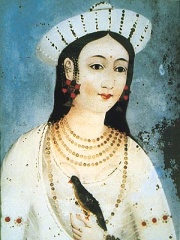
5. Mastani (1699 - 1740)
With an HPI of 58.26, Mastani is the 5th most famous Indian Companion. Her biography has been translated into 23 different languages.
Mastani (29 August 1699 – 28 April 1740) was either the daughter of Nizam Asaf Jah I of Hyderabad or Chhatrasal Bundela of Bundelkhand. She was the second wife of the Maratha Peshwa (Prime Minister) Baji Rao I. The marriage was arranged to promote diplomatic ties with the Maratha Empire. Her relationship within the Maratha Brahmin family has been subject of both admiration and controversy and well adapted in Indian novels and cinema.

6. Brian Horrocks (1895 - 1985)
With an HPI of 56.76, Brian Horrocks is the 6th most famous Indian Companion. His biography has been translated into 24 different languages.
Lieutenant-General Sir Brian Gwynne Horrocks, (7 September 1895 – 4 January 1985) was a British Army officer, chiefly remembered as the commander of XXX Corps in Operation Market Garden and other operations during the Second World War. He also served in the First World War and the Russian Civil War, was taken prisoner twice, and competed in the modern pentathlon at the 1924 Paris Olympics. Later he was a television presenter, wrote books on military history, and was Black Rod in the House of Lords for 14 years. In 1940 Horrocks commanded a battalion during the Battle of France, the first time he served under Bernard Montgomery, the most prominent British commander of the war. Montgomery later identified Horrocks as one of his most able officers, appointing him to corps commands in both North Africa and Europe. In 1943, Horrocks was seriously wounded and took more than a year to recover before returning to command a corps in Europe. It is likely that this period out of action meant he missed out on promotion; his contemporary corps commanders in North Africa, Oliver Leese and Miles Dempsey, went on to command at army level and above. Horrocks' wound continued to impair his health and led to his early retirement from the army after the war. Since 1945, Horrocks has been regarded by some as one of the most successful British generals of the war, "a man who really led, a general who talked to everyone, down to the simplest private soldier" and the "beau ideal of a corps commander". General Dwight D. Eisenhower, the Supreme Allied Commander in Western Europe, called him "the outstanding British general under Montgomery".

7. Salima Sultan Begum (1539 - 1613)
With an HPI of 56.21, Salima Sultan Begum is the 7th most famous Indian Companion. Her biography has been translated into 18 different languages.
Salima Sultan Begum (23 February 1539 – 2 January 1613) was the third wife and chief consort of the Mughal emperor Akbar, and a granddaughter of Babur. Salima was the daughter of Akbar's paternal aunt, Gulrukh Begum, and her husband, the Viceroy of Kannauj, Nuruddin Muhammad Mirza. She was initially betrothed to Akbar's regent, Bairam Khan, by her maternal uncle, Humayun. The bride was probably a reward for the surpassing services done by Bairam for Humayun. The couple, who had a considerable age difference of approximately forty years, were married in 1557 after Akbar had succeeded Humayun as the third Mughal emperor. However, this brief union, which did not produce any children, lasted for only three years before Bairam Khan was assassinated by a band of Afghans in 1561. After his death, Salima was married to her first cousin, Akbar. She remained childless in both her marriages, but she raised the second son of Akbar, Murad Mirza for the first few years. Salima was a senior-ranking wife of Akbar and had much influence over her husband and his son, Jahangir. She wielded major political influence in the Mughal court during her husband's reign as well as during his successor's (Jahangir) reign. Her name, however, appears in the histories as a reader, poet, who wrote under the pseudonym of Makhfi (lit. 'Hidden One') and as pleading with Akbar for Jahangir's forgiveness.

8. Kashibai (1703 - 1758)
With an HPI of 52.57, Kashibai is the 8th most famous Indian Companion. Her biography has been translated into 18 different languages.
Kashibai Bhat was the first wife of Bajirao I, the Peshwa (Prime Minister) to the fourth Maratha Chhatrapati (Emperor) Shahu. With Bajirao, she had four children, including Balaji Baji Rao and Ragunath Rao. Balaji succeeded Bajirao as Peshwa upon the latter's death in 1740. Also following Bajirao's death, Kashibai fostered her step-son, Shamsher Bahadur, whose mother was Bajirao's second wife, Mastani.
People
Pantheon has 8 people classified as Indian companions born between 1539 and 1895. Of these 8, 1 (12.50%) of them are still alive today. The most famous living Indian companions include Sita. The most famous deceased Indian companions include Mumtaz Mahal, Mariam-uz-Zamani, and Jagat Gosain.
Living Indian Companions
Go to all RankingsDeceased Indian Companions
Go to all RankingsMumtaz Mahal
1593 - 1631
HPI: 85.84
Mariam-uz-Zamani
1542 - 1623
HPI: 73.82
Jagat Gosain
1573 - 1619
HPI: 63.83
Mastani
1699 - 1740
HPI: 58.26
Brian Horrocks
1895 - 1985
HPI: 56.76
Salima Sultan Begum
1539 - 1613
HPI: 56.21
Kashibai
1703 - 1758
HPI: 52.57

